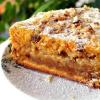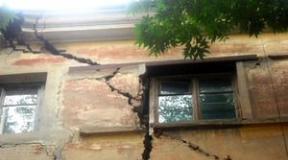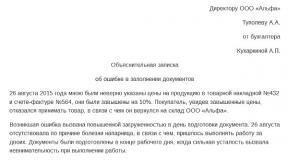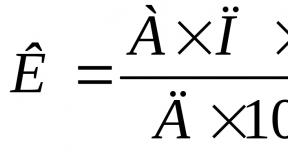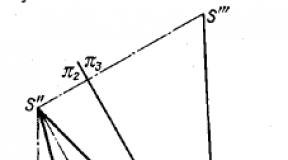Ordinary and decimal fractions and operations on them. How to represent a fraction as a decimal fraction How to represent a decimal fraction as a rule
Already in elementary school, students are faced with fractions. And then they appear in every topic. It is impossible to forget actions with these numbers. Therefore, you need to know all the information about ordinary and decimal fractions. These concepts are simple, the main thing is to understand everything in order.
Why are fractions needed?
The world around us consists of whole objects. Therefore, there is no need for shares. But everyday life constantly pushes people to work with parts of objects and things.
For example, chocolate consists of several slices. Consider the situation where its tile is formed by twelve rectangles. If you divide it into two, you get 6 parts. It will be well divided into three. But the five will not be able to give a whole number of slices of chocolate.
By the way, these slices are already fractions. And their further division leads to the appearance of more complex numbers.
What is a "fraction"?
This is a number consisting of parts of one. Outwardly, it looks like two numbers separated by a horizontal or slash. This feature is called fractional. The number written on the top (left) is called the numerator. The one on the bottom (right) is the denominator.
In fact, the fractional bar turns out to be a division sign. That is, the numerator can be called a dividend, and the denominator can be called a divisor.
What are the fractions?
In mathematics, there are only two types of them: ordinary and decimal fractions. Schoolchildren get acquainted with the first ones in the elementary grades, calling them simply “fractions”. The second learn in the 5th grade. That's when these names appear.
Common fractions are all those that are written as two numbers separated by a bar. For example, 4/7. Decimal is a number in which the fractional part has a positional notation and is separated from the integer with a comma. For example, 4.7. Students need to be clear that the two examples given are completely different numbers.
Every simple fraction can be written as a decimal. This statement is almost always true in reverse as well. There are rules that allow you to write a decimal fraction as an ordinary fraction.

What subspecies do these types of fractions have?
It is better to start in chronological order, as they are being studied. Common fractions come first. Among them, 5 subspecies can be distinguished.
Correct. Its numerator is always less than the denominator.
Wrong. Its numerator is greater than or equal to the denominator.
Reducible / irreducible. It can be either right or wrong. Another thing is important, whether the numerator and denominator have common factors. If there are, then they are supposed to divide both parts of the fraction, that is, to reduce it.
Mixed. An integer is assigned to its usual correct (incorrect) fractional part. And it always stands on the left.
Composite. It is formed from two fractions divided into each other. That is, it has three fractional features at once.
Decimals have only two subspecies:
final, that is, one in which the fractional part is limited (has an end);
infinite - a number whose digits after the decimal point do not end (they can be written endlessly).

How to convert decimal to ordinary?
If this is a finite number, then an association based on the rule is applied - as I hear, so I write. That is, you need to read it correctly and write it down, but without a comma, but with a fractional line.
As a hint about the required denominator, remember that it is always a one and a few zeros. The latter need to be written as many as the digits in the fractional part of the number in question.
How to convert decimal fractions to ordinary ones if their whole part is missing, that is, equal to zero? For example, 0.9 or 0.05. After applying the specified rule, it turns out that you need to write zero integers. But it is not indicated. It remains to write down only the fractional parts. For the first number, the denominator will be 10, for the second - 100. That is, the indicated examples will have numbers as answers: 9/10, 5/100. Moreover, the latter turns out to be possible to reduce by 5. Therefore, the result for it must be written 1/20.
How to make an ordinary fraction from a decimal if its integer part is different from zero? For example, 5.23 or 13.00108. Both examples read the integer part and write its value. In the first case, this is 5, in the second, 13. Then you need to move on to the fractional part. With them it is necessary to carry out the same operation. The first number has 23/100, the second has 108/100000. The second value needs to be reduced again. The answer is mixed fractions: 5 23/100 and 13 27/25000.

How to convert an infinite decimal to a common fraction?
If it is non-periodic, then such an operation cannot be carried out. This fact is due to the fact that each decimal fraction is always converted to either final or periodic.
The only thing that is allowed to be done with such a fraction is to round it. But then the decimal will be approximately equal to that infinite. It can already be turned into an ordinary one. But the reverse process: converting to decimal - will never give the initial value. That is, infinite non-periodic fractions are not translated into ordinary fractions. This must be remembered.
How to write an infinite periodic fraction in the form of an ordinary?
In these numbers, one or more digits always appear after the decimal point, which are repeated. They are called periods. For example, 0.3(3). Here "3" in the period. They are classified as rational, as they can be converted into ordinary fractions.
Those who have encountered periodic fractions know that they can be pure or mixed. In the first case, the period starts immediately from the comma. In the second, the fractional part begins with any numbers, and then the repetition begins.
The rule by which you need to write an infinite decimal in the form of an ordinary fraction will be different for these two types of numbers. It is quite easy to write pure periodic fractions as ordinary fractions. As with the final ones, they need to be converted: write the period into the numerator, and the number 9 will be the denominator, repeating as many times as there are digits in the period.
For example, 0,(5). The number does not have an integer part, so you need to immediately proceed to the fractional part. Write 5 in the numerator, and write 9 in the denominator. That is, the answer will be the fraction 5/9.
A rule on how to write a common decimal fraction that is a mixed fraction.
Look at the length of the period. So much 9 will have a denominator.
Write down the denominator: first nines, then zeros.
To determine the numerator, you need to write the difference of two numbers. All digits after the decimal point will be reduced, along with the period. Subtractable - it is without a period.
For example, 0.5(8) - write the periodic decimal fraction as a common fraction. The fractional part before the period is one digit. So zero will be one. There is also only one digit in the period - 8. That is, there is only one nine. That is, you need to write 90 in the denominator.
To determine the numerator from 58, you need to subtract 5. It turns out 53. For example, you will have to write 53/90 as an answer.

How are common fractions converted to decimals?
The simplest option is a number whose denominator is the number 10, 100, and so on. Then the denominator is simply discarded, and a comma is placed between the fractional and integer parts.
There are situations when the denominator easily turns into 10, 100, etc. For example, the numbers 5, 20, 25. It is enough to multiply them by 2, 5 and 4, respectively. Only it is necessary to multiply not only the denominator, but also the numerator by the same number.
For all other cases, a simple rule will come in handy: divide the numerator by the denominator. In this case, you may get two answers: a final or a periodic decimal fraction.
Operations with common fractions
Addition and subtraction
Students get to know them earlier than others. And at first the fractions have the same denominators, and then different. General rules can be reduced to such a plan.
Find the least common multiple of the denominators.
Write additional factors to all ordinary fractions.
Multiply the numerators and denominators by the factors defined for them.
Add (subtract) the numerators of fractions, and leave the common denominator unchanged.
If the numerator of the minuend is less than the subtrahend, then you need to find out whether we have a mixed number or a proper fraction.
In the first case, the integer part needs to take one. Add a denominator to the numerator of a fraction. And then do the subtraction.
In the second - it is necessary to apply the rule of subtraction from a smaller number to a larger one. That is, subtract the modulus of the minuend from the modulus of the subtrahend, and put the “-” sign in response.
Look carefully at the result of addition (subtraction). If you get an improper fraction, then it is supposed to select the whole part. That is, divide the numerator by the denominator.
Multiplication and division
For their implementation, fractions do not need to be reduced to a common denominator. This makes it easier to take action. But they still have to follow the rules.
When multiplying ordinary fractions, it is necessary to consider the numbers in the numerators and denominators. If any numerator and denominator have a common factor, then they can be reduced.
Multiply numerators.
Multiply the denominators.
If you get a reducible fraction, then it is supposed to be simplified again.
When dividing, you must first replace division with multiplication, and the divisor (second fraction) with a reciprocal (swap the numerator and denominator).
Then proceed as in multiplication (starting from point 1).
In tasks where you need to multiply (divide) by an integer, the latter is supposed to be written as an improper fraction. That is, with a denominator of 1. Then proceed as described above.

Operations with decimals
Addition and subtraction
Of course, you can always turn a decimal into a common fraction. And act according to the already described plan. But sometimes it is more convenient to act without this translation. Then the rules for their addition and subtraction will be exactly the same.
Equalize the number of digits in the fractional part of the number, that is, after the decimal point. Assign the missing number of zeros in it.
Write fractions so that the comma is under the comma.
Add (subtract) like natural numbers.
Remove the comma.
Multiplication and division
It is important that you do not need to append zeros here. Fractions are supposed to be left as they are given in the example. And then go according to plan.
For multiplication, you need to write fractions one under the other, not paying attention to commas.
Multiply like natural numbers.
Put a comma in the answer, counting from the right end of the answer as many digits as they are in the fractional parts of both factors.
To divide, you must first convert the divisor: make it a natural number. That is, multiply it by 10, 100, etc., depending on how many digits are in the fractional part of the divisor.
Multiply the dividend by the same number.
Divide a decimal by a natural number.
Put a comma in the answer at the moment when the division of the whole part ends.

What if there are both types of fractions in one example?
Yes, in mathematics there are often examples in which you need to perform operations on ordinary and decimal fractions. There are two possible solutions to these problems. You need to objectively weigh the numbers and choose the best one.
First way: represent ordinary decimals
It is suitable if, when dividing or converting, final fractions are obtained. If at least one number gives a periodic part, then this technique is prohibited. Therefore, even if you do not like working with ordinary fractions, you will have to count them.
The second way: write decimal fractions as ordinary
This technique is convenient if there are 1-2 digits in the part after the decimal point. If there are more of them, a very large ordinary fraction can turn out and decimal entries will allow you to calculate the task faster and easier. Therefore, it is always necessary to soberly evaluate the task and choose the simplest solution method.
Decimal fraction- variety fractions, which has a "round" number in the denominator: 10, 100, 1000, etc., for example, fraction 5/10 has a decimal notation of 0.5. Based on this principle, fraction can be presented in form decimal fractions.
Instruction
Suppose we need to imagine form decimal fraction 18/25.
First you need to make sure that one of the "round" numbers appears in the denominator: 100, 1000, etc. To do this, you need to multiply the denominator by 4. But by 4, you will need to multiply both the numerator and the denominator.
Multiplying the numerator and denominator fractions 18/25 times 4 is 72/100. This is being recorded fraction in decimal form so: 0.72.
A fraction in mathematics is a rational number equal to one or more parts into which a unit is divided. In this case, the record of the fraction must contain an indication of two numbers: one of them indicates exactly how many shares the unit was divided into when creating this fraction, and the other - how many of these shares include a fractional number. If these two numbers are written as a numerator and denominator separated by a bar, then this recording format is called an “ordinary” fraction. However, there is another format for writing fractions, called "decimal".

The three-story form of writing numbers, in which the denominator is located above the numerator, and there is also a separating line between them, is not always convenient. Especially this inconvenience began to manifest itself with the mass distribution of personal computers. The decimal form of representation of fractions is devoid of this drawback - it is not required to indicate the numerator in it, since by definition it is always equal to ten to a negative power. Therefore, a fractional number can be written in one line, although its length in most cases will be much larger than the length of the corresponding ordinary fraction.
Another advantage of writing numbers in decimal format is that they are much easier to compare. Since the denominator of each digit of two such numbers is the same, it is enough to compare only two digits of the corresponding digits, while when comparing ordinary fractions, both the numerator and the denominator of each of them must be taken into account. This advantage is important not only for humans, but also for computers - comparing numbers in decimal format is easy enough to program.
There are centuries-old rules for addition, multiplication, and other mathematical operations that allow you to perform calculations on paper or in your mind with numbers in decimal format. This is another advantage of this format over ordinary fractions. Although with the development of computer technology, when the calculator is even in the watch, it is becoming less and less noticeable.
The described advantages of the decimal format for recording fractional numbers show that its main purpose is to simplify the work with mathematical quantities. This format also has disadvantages - for example, to write periodic fractions to a decimal fraction, you also have to add a number in brackets, and irrational numbers in decimal format always have an approximate value. However, at the current level of development of people and their technologies, it is much more convenient to use than the usual format for recording fractions.
A decimal fraction is a fraction in which the denominator is a natural power of 10. Such, for example, is a fraction. This fraction can be written in the following form: write out the numbers of the numerator in a line and separate with a comma on the right as many of them as there are zeros in the denominator, namely :
![]()
In such a record, the numbers to the left of the decimal point form the integer part, and the numbers to the right of the decimal point form the fractional part of this decimal fraction.
Let p/q be some positive rational number. From arithmetic, the division process is well known, which allows you to represent a number as a decimal fraction. The essence of the division process is that first find what is the largest integer number of times q is contained in p; if p is a multiple of q, then this is where the division process ends. Otherwise, a remainder appears. Next, they find how many tenths of q are contained in this remainder, and at this step the process may end, or a new remainder will appear. In the latter case, find how many hundredths of q it contains, and so on.
If the denominator q has no other prime divisors than 2 or 5, then after a finite number of steps the remainder will be equal to zero, the division process will end and the given ordinary fraction will turn into a final decimal fraction. In fact, in this case, you can always choose such an integer that after multiplying the numerator and denominator of the given fraction by it, you get a fraction equal to it, in which the denominator will be a natural power of ten. Such, for example, is a fraction
which can be represented as follows:
However, without making these transformations, dividing the numerator by the denominator, the reader will get the same result:
If the denominator of an irreducible fraction has at least one prime divisor other than 2 or 5, then the process of dividing by q will never end (none of the subsequent remainders will turn to zero).
![]()
After dividing, we find
![]()
To write the result obtained in this example, the periodically repeating numbers 0 and 6 are enclosed in parentheses and written:
![]()
In this example and in other similar cases, the division operation does not result in a final decimal result. It is possible, generalizing the concept of a decimal fraction, to still say that the quotient 965/132 is represented by an infinite periodic fraction. Repeating numbers 06 are called the period of this fraction, and their number, equal in our example, is the length of the period.
To understand the reason for the phenomenon of the periodicity of a fraction, let us analyze, for example, the process of division by 7. If the division is not completely performed, then a remainder appears, which can have only one of the following values: 1, 2, 3, 4, 5, 6. And on each from the next steps, the remainder will again have one of these six values. Therefore, no later than at the seventh step, we will inevitably meet with one of the remainder values that have already appeared before. Starting from this point, the division process will become periodic. Periodically, both the values of the remainders and the numbers of the quotient will be repeated. This reasoning is applicable in the case of any other divisor.
Thus, any ordinary fraction is represented by a finite or infinite periodic decimal fraction. It is remarkable that, conversely, any periodic decimal fraction can be represented as an ordinary fraction. Let's show how this action is performed. In this case, the formula for the sum of an infinitely decreasing geometric progression is used (paragraph 92).
![]()
can be understood like this:
here the members of the right side, starting from the second, form an infinite geometric progression with the denominator and the first member
Using formula (92.2):
It is clear that the same process will allow any given infinite periodic fraction to be represented in the form of an ordinary fraction (and, as can be shown, exactly the one from which the given infinite periodic fraction in turn is obtained in the process of division). However, there is one exception here. Consider a fraction
![]()
and apply to it the process of converting to an ordinary fraction:
We have come to the number 1/2, which is represented by the final decimal fraction
A similar result will be obtained whenever the period of a given infinite fraction has the form (9). Therefore, we identify such pairs of numbers, such as, for example,

Sometimes it is also useful to allow records of the form
representing formally finite decimal fractions as infinite with a period (0).
Everything said about the conversion of an ordinary fraction to a decimal periodic fraction and vice versa applied to positive rational numbers. In the case of a negative number, you can do two things.
1) Take a positive number opposite to a given negative number, turn it into a decimal fraction, and then put a minus sign in front of it. For example, for - 5/3 we get
2) Present this negative rational number as the sum of its integer part (negative) and its fractional part (non-negative), and then convert only this fractional part of the number into a decimal fraction. For example:

To write numbers represented as the sum of their negative integer part and a finite or infinite decimal fraction, the following designation is adopted (an artificial form of writing a negative number):
![]()
Here, the minus sign is placed not before the whole fraction, but over its integer part, to emphasize that only the integer part is negative, and the fractional part following the comma is positive.
Such a notation creates uniformity in the notation of positive and negative decimal fractions and will be used in the future in the theory of decimal logarithms (section 28). We suggest the reader for practice to check the transition from one record to another in the examples:

Now it is already possible to formulate the final conclusion: any rational number can be represented by an infinite decimal periodic fraction, and, conversely, any such fraction defines a rational number. The finite decimal fraction also allows two forms of writing in the form of an infinite decimal fraction: with a period (0) and with a period (9).

In this article, we will analyze how converting common fractions to decimals, and also consider the reverse process - the conversion of decimal fractions to ordinary fractions. Here we will voice the rules for inverting fractions and give detailed solutions to typical examples.
Page navigation.
Converting common fractions to decimals
Let us denote the sequence in which we will deal with converting common fractions to decimals.
We will first look at how common fractions with denominators 10, 100, 1,000, … represent as decimal fractions. This is because decimal fractions are essentially a compact form of ordinary fractions with denominators 10, 100, ....
After that, we will go further and show how any ordinary fraction (not only with denominators 10, 100, ...) can be written as a decimal fraction. With this conversion of ordinary fractions, both finite decimal fractions and infinite periodic decimal fractions are obtained.
Now about everything in order.
Converting ordinary fractions with denominators 10, 100, ... to decimal fractions
Some regular fractions need "preliminary preparation" before converting to decimals. This applies to ordinary fractions, the number of digits in the numerator of which is less than the number of zeros in the denominator. For example, the common fraction 2/100 must first be prepared for conversion to a decimal fraction, but the fraction 9/10 does not need to be prepared.
The “preliminary preparation” of correct ordinary fractions for conversion to decimal fractions consists in adding so many zeros to the left in the numerator so that the total number of digits there becomes equal to the number of zeros in the denominator. For example, a fraction after adding zeros will look like .
After preparing the correct ordinary fraction, you can begin to convert it to a decimal fraction.
Let's give rule for converting a proper common fraction with a denominator of 10, or 100, or 1,000, ... into a decimal fraction. It consists of three steps:
- write down 0 ;
- put a decimal point after it;
- write down the number from the numerator (together with added zeros, if we added them).
Consider the application of this rule in solving examples.
Example.
Convert the proper fraction 37/100 to decimal.
Solution.
The denominator contains the number 100, which has two zeros in its entry. The numerator contains the number 37, there are two digits in its record, therefore, this fraction does not need to be prepared for conversion to a decimal fraction.
Now we write 0, put a decimal point, and write the number 37 from the numerator, while we get the decimal fraction 0.37.
Answer:
0,37 .
To consolidate the skills of translating regular ordinary fractions with numerators 10, 100, ... into decimal fractions, we will analyze the solution of another example.
Example.
Write the proper fraction 107/10,000,000 as a decimal.
Solution.
The number of digits in the numerator is 3, and the number of zeros in the denominator is 7, so this ordinary fraction needs to be prepared for conversion to decimal. We need to add 7-3=4 zeros to the left in the numerator so that the total number of digits there becomes equal to the number of zeros in the denominator. We get .
It remains to form the desired decimal fraction. To do this, firstly, we write down 0, secondly, we put a comma, thirdly, we write down the number from the numerator together with zeros 0000107 , as a result we have a decimal fraction 0.0000107 .
Answer:
0,0000107 .
Improper common fractions do not need preparation when converting to decimal fractions. The following should be adhered to rules for converting improper common fractions with denominators 10, 100, ... to decimal fractions:
- write down the number from the numerator;
- we separate with a decimal point as many digits on the right as there are zeros in the denominator of the original fraction.
Let's analyze the application of this rule when solving an example.
Example.
Convert improper common fraction 56 888 038 009/100 000 to decimal.
Solution.
Firstly, we write down the number from the numerator 56888038009, and secondly, we separate 5 digits on the right with a decimal point, since there are 5 zeros in the denominator of the original fraction. As a result, we have a decimal fraction 568 880.38009.
Answer:
568 880,38009 .
To convert to decimal mixed number, the denominator of the fractional part of which is the number 10, or 100, or 1000, ..., you can convert the mixed number into an improper ordinary fraction, after which the resulting fraction is converted into a decimal fraction. But you can also use the following the rule for converting mixed numbers with a denominator of the fractional part 10, or 100, or 1,000, ... into decimal fractions:
- if necessary, we perform “preliminary preparation” of the fractional part of the original mixed number by adding the required number of zeros on the left in the numerator;
- write down the integer part of the original mixed number;
- put a decimal point;
- we write the number from the numerator together with the added zeros.
Let's consider an example, in solving which we will perform all the necessary steps to represent a mixed number as a decimal fraction.
Example.
Convert mixed number to decimal.
Solution.
There are 4 zeros in the denominator of the fractional part, and the number 17 in the numerator, consisting of 2 digits, therefore, we need to add two zeros to the left in the numerator so that the number of characters there becomes equal to the number of zeros in the denominator. By doing this, the numerator will be 0017 .
Now we write down the integer part of the original number, that is, the number 23, put a decimal point, after which we write the number from the numerator together with the added zeros, that is, 0017, while we get the desired decimal fraction 23.0017.
Let's write down the whole solution briefly: ![]() .
.
Undoubtedly, it was possible to first represent the mixed number as an improper fraction, and then convert it to a decimal fraction. With this approach, the solution looks like this:
Answer:
23,0017 .
Converting ordinary fractions to finite and infinite periodic decimal fractions
Not only ordinary fractions with denominators 10, 100, ... can be converted into a decimal fraction, but ordinary fractions with other denominators. Now we will figure out how this is done.
In some cases, the original common fraction is easily reduced to one of the denominators 10, or 100, or 1,000, ... (see converting a common fraction to a new denominator), after which it is not difficult to represent the resulting fraction as a decimal fraction. For example, it is obvious that the fraction 2/5 can be reduced to a fraction with a denominator 10, for this you need to multiply the numerator and denominator by 2, which will give a fraction 4/10, which, according to the rules discussed in the previous paragraph, can be easily converted into a decimal fraction 0, four .
In other cases, you have to use a different way of converting an ordinary fraction into a decimal, which we will now consider.
To convert an ordinary fraction to a decimal fraction, the numerator of the fraction is divided by the denominator, the numerator is previously replaced by a decimal fraction equal to it with any number of zeros after the decimal point (we talked about this in the section equal and unequal decimals). In this case, the division is performed in the same way as division by a column of natural numbers, and in the quotient a decimal point is placed when the division of the integer part of the dividend ends. All this will become clear from the solutions of the examples given below.
Example.
Convert the common fraction 621/4 to decimal.
Solution.
We represent the number in the numerator 621 as a decimal fraction by adding a decimal point and a few zeros after it. To begin with, we will add 2 digits 0, later, if necessary, we can always add more zeros. So, we have 621.00 .
Now let's divide the number 621,000 by 4 by a column. The first three steps are no different from dividing by a column of natural numbers, after which we arrive at the following picture: 
So we got to the decimal point in the dividend, and the remainder is different from zero. In this case, we put a decimal point in the quotient, and continue the division by a column, ignoring the commas: 
This division is completed, and as a result we got the decimal fraction 155.25, which corresponds to the original ordinary fraction.
Answer:
155,25 .
To consolidate the material, consider the solution of another example.
Example.
Convert the common fraction 21/800 to decimal.
Solution.
To convert this common fraction to a decimal, let's divide the decimal fraction 21,000 ... by 800 by a column. After the first step, we will have to put a decimal point in the quotient, and then continue the division: 
Finally, we got the remainder 0, on this the conversion of the ordinary fraction 21/400 to the decimal fraction is completed, and we have come to the decimal fraction 0.02625.
Answer:
0,02625 .
It may happen that when dividing the numerator by the denominator of an ordinary fraction, we never get a remainder of 0. In these cases, the division can be continued as long as desired. However, starting from a certain step, the remainders begin to repeat periodically, while the digits in the quotient also repeat. This means that the original common fraction is converted to infinite periodic decimal. Let's show this with an example.
Example.
Write the common fraction 19/44 as a decimal.
Solution.
To convert an ordinary fraction to a decimal, we perform division by a column: 
It is already clear that when dividing, the remainders 8 and 36 began to repeat, while in the quotient the numbers 1 and 8 are repeated. Thus, the original ordinary fraction 19/44 is translated into a periodic decimal fraction 0.43181818…=0.43(18) .
Answer:
0,43(18) .
In conclusion of this paragraph, we will figure out which ordinary fractions can be converted to final decimal fractions, and which ones can only be converted to periodic ones.
Let it be in front of us irreducible common fraction(if the fraction is reduced, then we first perform fraction reduction), and we need to find out what decimal fraction it can be converted to - a finite or a periodic one.
It is clear that if an ordinary fraction can be reduced to one of the denominators 10, 100, 1000, ..., then the resulting fraction can be easily converted into a final decimal fraction according to the rules discussed in the previous paragraph. But to the denominators 10, 100, 1,000, etc. not all ordinary fractions are given. Only fractions can be reduced to such denominators, the denominators of which are at least one of the numbers 10, 100, ... And what numbers can be divisors of 10, 100, ...? The numbers 10, 100, … will allow us to answer this question, and they are as follows: 10=2 5 , 100=2 2 5 5 , 1 000=2 2 2 5 5 5, … . It follows that the divisors of 10, 100, 1,000, etc. there can only be numbers whose decompositions into prime factors contain only the numbers 2 and (or) 5 .
Now we can make a general conclusion about the conversion of ordinary fractions to decimal fractions:
- if only the numbers 2 and (or) 5 are present in the decomposition of the denominator into prime factors, then this fraction can be converted into a final decimal fraction;
- if, in addition to two and fives, there are other prime numbers in the expansion of the denominator, then this fraction is translated into an infinite decimal periodic fraction.
Example.
Without converting ordinary fractions to decimals, tell me which of the fractions 47/20, 7/12, 21/56, 31/17 can be converted to a final decimal fraction, and which can only be converted to a periodic one.
Solution.
The prime factorization of the denominator of the fraction 47/20 has the form 20=2 2 5 . There are only twos and fives in this expansion, so this fraction can be reduced to one of the denominators 10, 100, 1000, ... (in this example, to the denominator 100), therefore, can be converted to a final decimal fraction.
The prime factorization of the denominator of the fraction 7/12 has the form 12=2 2 3 . Since it contains a simple factor 3 different from 2 and 5, this fraction cannot be represented as a finite decimal fraction, but can be converted to a periodic decimal fraction.
Fraction 21/56 - contractible, after reduction it takes the form 3/8. The decomposition of the denominator into prime factors contains three factors equal to 2, therefore, the ordinary fraction 3/8, and hence the fraction equal to it 21/56, can be translated into a final decimal fraction.
Finally, the expansion of the denominator of the fraction 31/17 is itself 17, therefore, this fraction cannot be converted to a finite decimal fraction, but it can be converted to an infinite periodic one.
Answer:
47/20 and 21/56 can be converted to a final decimal, while 7/12 and 31/17 can only be converted to a periodic decimal.
Common fractions do not convert to infinite non-repeating decimals
The information of the previous paragraph raises the question: “Can an infinite non-periodic fraction be obtained when dividing the numerator of a fraction by the denominator”?
Answer: no. When translating an ordinary fraction, either a finite decimal fraction or an infinite periodic decimal fraction can be obtained. Let's explain why this is so.
From divisibility theorems with remainder it is clear that the remainder is always less than the divisor, that is, if we divide some integer by an integer q , then only one of the numbers 0, 1, 2, ..., q−1 can be the remainder. It follows that after the division of the integer part of the numerator of an ordinary fraction by the denominator q is completed, after no more than q steps, one of the following two situations will arise:
- either we get the remainder 0 , this will end the division, and we will get the final decimal fraction;
- or we will get a remainder that has already appeared before, after which the remainders will begin to repeat as in the previous example (since when dividing equal numbers by q, equal remainders are obtained, which follows from the already mentioned divisibility theorem), so an infinite periodic decimal fraction will be obtained.
There can be no other options, therefore, when converting an ordinary fraction to a decimal fraction, an infinite non-periodic decimal fraction cannot be obtained.
It also follows from the reasoning given in this paragraph that the length of the period of a decimal fraction is always less than the value of the denominator of the corresponding ordinary fraction.
Convert decimals to common fractions
Now let's figure out how to convert a decimal fraction to an ordinary one. Let's start by converting final decimals to common fractions. After that, consider the method of inverting infinite periodic decimal fractions. In conclusion, let's say about the impossibility of converting infinite non-periodic decimal fractions into ordinary fractions.
Converting end decimals to common fractions
Getting an ordinary fraction, which is written as a final decimal fraction, is quite simple. The rule for converting a final decimal fraction to an ordinary fraction consists of three steps:
- firstly, write the given decimal fraction into the numerator, having previously discarded the decimal point and all zeros on the left, if any;
- secondly, write one in the denominator and add as many zeros to it as there are digits after the decimal point in the original decimal fraction;
- thirdly, if necessary, reduce the resulting fraction.
Let's consider examples.
Example.
Convert the decimal 3.025 to a common fraction.
Solution.
If we remove the decimal point in the original decimal fraction, then we get the number 3025. It has no zeros on the left that we would discard. So, in the numerator of the required fraction we write 3025.
We write the number 1 in the denominator and add 3 zeros to the right of it, since there are 3 digits in the original decimal fraction after the decimal point.
So we got an ordinary fraction 3 025/1 000. This fraction can be reduced by 25, we get  .
.
Answer:
 .
.
Example.
Convert decimal 0.0017 to common fraction.
Solution.
Without a decimal point, the original decimal fraction looks like 00017, discarding zeros on the left, we get the number 17, which is the numerator of the desired ordinary fraction.
In the denominator we write a unit with four zeros, since in the original decimal fraction there are 4 digits after the decimal point.
As a result, we have an ordinary fraction 17/10,000. This fraction is irreducible, and the conversion of a decimal fraction to an ordinary one is completed.
Answer:
 .
.
When the integer part of the original final decimal fraction is different from zero, then it can be immediately converted to a mixed number, bypassing the ordinary fraction. Let's give rule for converting a final decimal to a mixed number:
- the number before the decimal point must be written as the integer part of the desired mixed number;
- in the numerator of the fractional part, you need to write the number obtained from the fractional part of the original decimal fraction after discarding all zeros on the left in it;
- in the denominator of the fractional part, you need to write the number 1, to which, on the right, add as many zeros as there are digits in the entry of the original decimal fraction after the decimal point;
- if necessary, reduce the fractional part of the resulting mixed number.
Consider an example of converting a decimal fraction to a mixed number.
Example.
Express decimal 152.06005 as a mixed number





